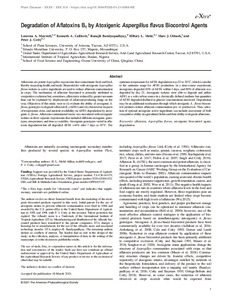| dc.contributor.author | Maxwell, L.A. |
| dc.contributor.author | Callicott, K. |
| dc.contributor.author | Bandyopadhyay, R. |
| dc.contributor.author | Mehl, H.L. |
| dc.contributor.author | Orbach, M.J. |
| dc.contributor.author | Cotty, P.J. |
| dc.date.accessioned | 2022-01-31T10:36:13Z |
| dc.date.available | 2022-01-31T10:36:13Z |
| dc.date.issued | 2021-09 |
| dc.identifier.citation | Maxwell, L.A., Callicott, K., Bandyopadhyay, R., Mehl, H.L., Orbach, M.J. & Cotty, P.J. (2021). Degradation of aflatoxins B1 by atoxigenic Aspergillus flavus biocontrol agents. Plant Disease, 105(9), 2343-2350. |
| dc.identifier.issn | 0191-2917 |
| dc.identifier.uri | https://hdl.handle.net/20.500.12478/7325 |
| dc.description.abstract | Aflatoxins are potent Aspergillus mycotoxins that contaminate food and feed, thereby impacting health and trade. Biopesticides with atoxigenic Aspergillus flavus isolates as active ingredients are used to reduce aflatoxin contamination in crops. The mechanism of aflatoxin biocontrol is primarily attributed to competitive exclusion but, sometimes, aflatoxin is reduced by greater amounts than can be explained by displacement of aflatoxin-producing fungi on the crop. Objectives of this study were to (i) evaluate the ability of atoxigenic A. flavus genotypes to degrade aflatoxin B1 (AFB1) and (ii) characterize impacts of temperature, time, and nutrient availability on AFB1 degradation by atoxigenic A. flavus. Aflatoxin-contaminated maize was inoculated with atoxigenic isolates in three separate experiments that included different atoxigenic genotypes, temperature, and time as variables. Atoxigenic genotypes varied in aflatoxin degradation but all degraded AFB1 >44% after 7 days at 30°C. The optimum temperature for AFB1 degradation was 25 to 30°C, which is similar to the optimum range for AFB1 production. In a time-course experiment, atoxigenics degraded 40% of AFB1 within 3 days, and 80% of aflatoxin was degraded by day 21. Atoxigenic isolates were able to degrade and utilize AFB1 as a sole carbon source in a chemically defined medium but quantities of AFB1 degraded declined as glucose concentrations increased. Degradation may be an additional mechanism through which atoxigenic A. flavus biocontrol products reduce aflatoxin contamination pre- or postharvest. Thus, selection of optimal atoxigenic active ingredients can include assessment of both competitive ability in agricultural fields and their ability to degrade aflatoxins. |
| dc.description.sponsorship | United States Department of Agriculture, Foreign Agricultural Service |
| dc.description.sponsorship | Bill & Melinda Gates Foundation |
| dc.format.extent | 2343-2350 |
| dc.language.iso | en |
| dc.subject | Maize |
| dc.subject | Aflatoxins |
| dc.subject | Aspergillus Flavus |
| dc.subject | Biological Control Agents |
| dc.subject | Degradation |
| dc.title | Degradation of aflatoxins B1 by atoxigenic Aspergillus flavus biocontrol agents |
| dc.type | Journal Article |
| cg.contributor.crp | Maize |
| cg.contributor.affiliation | University of Arizona |
| cg.contributor.affiliation | Eduado Mondlane University |
| cg.contributor.affiliation | United States Department of Agriculture–Agricultural Research Service |
| cg.contributor.affiliation | International Institute of Tropical Agriculture |
| cg.contributor.affiliation | Ocean University of China |
| cg.coverage.region | Africa |
| cg.coverage.region | West Africa |
| cg.coverage.country | Nigeria |
| cg.coverage.hub | Headquarters and Western Africa Hub |
| cg.researchtheme | Plant Production and Health |
| cg.identifier.bibtexciteid | MAXWELL:2021 |
| cg.isijournal | ISI Journal |
| cg.authorship.types | CGIAR and developing country institute |
| cg.iitasubject | Aflatoxin |
| cg.iitasubject | Agronomy |
| cg.journal | Plant Disease |
| cg.notes | Published online: 12 Oct 2021 |
| cg.accessibilitystatus | Open Access |
| cg.reviewstatus | Peer Review |
| cg.usagerightslicense | Creative Commons Attribution 4.0 (CC BY 0.0) |
| cg.targetaudience | Scientists |
| cg.identifier.doi | https://dx.doi.org/10.1094/pdis-01-21-0066-re |
| cg.iitaauthor.identifier | Ranajit Bandyopadhyay: 0000-0003-2422-4298 |
| cg.futureupdate.required | No |
| cg.identifier.issue | 9 |
| cg.identifier.volume | 105 |

